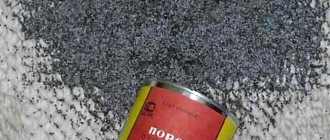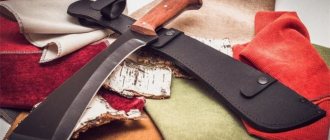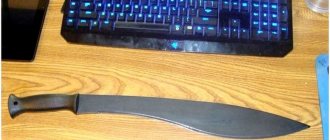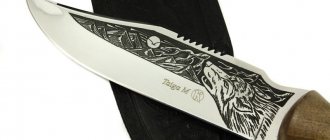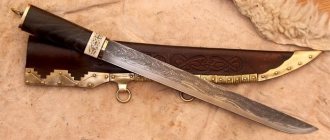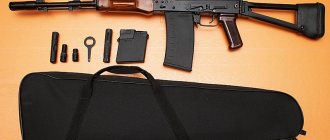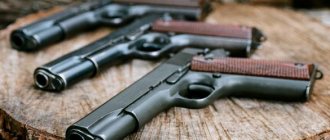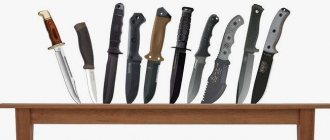On the sugar plantations of Florida, in the subtropics of South America and in the mountainous regions of Nepal, a tool such as a machete is widely used. It is used in a variety of ways and is used in both harvesting bananas and opening coconuts. Some areas adopt the machete as a national symbol. However, this universal knife is also universal in that it is suitable not only for collecting reeds, but also as a formidable weapon of self-defense.
The history of the machete, a tool originally created as a tool of labor, is quite brutal. He was repeatedly involved in various jungle wars, revolutionary and liberation movements. The machete also appeared on the pages of the history of the underworld. Even today, its history is not over, and today the machete is a combat tool that can arouse genuine interest among weapon lovers.
The genesis of the machete is not entirely obvious, so it is quite difficult to say for sure which word the name of this knife came from. Linguists claim that "Machete" is a compound word derived from the Spanish "macho" by adding the suffix -ete. Macho, as you know, means “brave”, “courageous”. However, in one variation, macho is a hammer, that is, machete can literally mean “small hammer.”
The versatility of the machete is confirmed by the wide range of applications of this tool.
- It is used in agriculture. The cutting properties of such a convenient knife are used when preparing or harvesting corn, sugar cane, oats, buckwheat, and millet.
- Machetes are used to fight forest fires. When fire spreads at a high rate, it is important to quickly clear a large area of dry wood and vegetation.
- They use machetes to create paths that are constantly overgrown with vines and other vegetation. It is the machete that is most convenient to use here, since sharpening the tool is very easy, as is its manufacture.
- During the construction of Campsites. A well-sharpened knife allows you to process wood.
- Machetes are also used in cooking. They are good at chopping vegetables and fruits, cutting up meat, and crushing nuts.
- The machete is an independent weapon.
Technical characteristics and features of the machete
The classic machete has a rather simple shape, with a fairly wide blade, a tip that is practically not suitable for piercing, and a one-sided sharpening. The blade is usually made from 40 to 60 cm long, but there are also more bulky specimens. But the thickness of the blade is almost always minimal (from 3 to 4 millimeters).
The handle is made of simple materials, mainly wood; more modern versions may have handles made of various plastics and composites - but this is more of a tribute to fashion - after all, a classic machete
simple and hardworking. The handle is often made by overhead mounting.
Main feature of the machete
- the complete absence of a guard and any protection of the hand from slipping onto the blade - after all, the vocation of a machete is chopping blows. You can often find wrist lanyards on the handle - they are more than necessary. The tool is so simple that you can make and maintain it almost on your knees.
It is difficult and practically impossible to find any decorative parts on a machete - everything is conservative and functional - no decorations.
Currently, a huge variety of machetes are manufactured. Manufacturers offer us solutions for machetes with almost a full-fledged hacksaw blade on the blade butt, and massive specimens that can be used as a crowbar, an ax, and even a small shovel.
In fact, the machete is a rather interesting tool, which has also proven itself as a full-fledged edged weapon.
, providing enormous scope for the imagination of knife makers.
The best long machetes
The large size and heavy weight of such models allow them to be used to solve the most complex problems. They are distinguished by high blade strength and are capable of cutting thick stems, branches of trees, bushes, etc.
Gerber Bolo (31002076N)
5
★★★★★
editorial assessment
98%
buyers recommend this product
The Gerber Bolo blade has a distinctive ridge for increased cutting power. Anti-corrosion coating guarantees long-term operation in conditions of high humidity. The textured handle will provide a secure grip even when wet and is not afraid of sharp impacts.
The total length of the instrument is 57.2 centimeters, the thickness of the butt is 2 mm. The kit includes a nylon sheath for storing and safely carrying the weapon. The locking D-element allows you to secure the machete to equipment, a belt or a backpack.
Advantages:
- strength resistance to corrosion;
- comfort of wearing;
- reliable grip;
- long service life.
Flaws:
- high price.
Gerber Bolo (31002076N) is suitable for use in any conditions. The machete is equally good for household chores or for use on a long hike.
Ontario OKC 22 Heavy Duty
4.9
★★★★★
editorial assessment
94%
buyers recommend this product
One of the features of the model is the D-shaped handle. It provides ease of holding and does not allow the machete to fall out of the palm during intensive chopping. The use of zinc phosphate coating guarantees the metal's resistance to corrosion throughout its entire service life.
The weight of the weapon is 710 g, the thickness of the butt is 3.2 mm. The blade is made from 1075 Carbon Steel and the handle is molded plastic. For ease of carrying and storage, a special sheath is provided. Double-sided symmetrical sharpening facilitates comfortable work from any position.
Advantages:
- reliable grip;
- strong and durable blade with corrosion protection;
- ease of storage.
Flaws:
- requires long sharpening.
Ontario Heavy Duty is not afraid of difficult operating conditions, so it is suitable for use on a backpacking trip if its heavy weight is not a problem.
READ ALSO
15 best axes
Truper Maca-22
4.8
★★★★★
editorial assessment
88%
buyers recommend this product
The model's blade is made of SAE 1071 steel and is highly durable and resistant to mechanical damage. The curved shape provides convenience when cutting down thickets and allows you to use less effort.
The total length of the machete is 690 mm, weight - 760 grams. The handle is made of plastic and does not weigh down the structure. A special hole makes it possible to thread a safety belt.
Advantages:
- comfortable to hold and work with;
- high strength;
- curved blade;
- wear-resistant handle.
Flaws:
- considerable weight.
Truper Maca-22 is designed for cleaning work in the garden or country house.
Cold Steel 97AD18Z Latin D-Guard
4.7
★★★★★
editorial assessment
86%
buyers recommend this product
The machete handle is made of polypropylene, can withstand heavy shock loads and is resistant to rapid wear. The blade is made from 1055 Carbon steel. Its main feature is increased hardness, which allows you to use the machete in any conditions without fear of damaging the blade.
The weight of the weapon is 519 grams with a blade thickness of 2 mm. The protective D-ring promotes a secure and secure grip. All structural elements are treated to protect against corrosion and retain their quality characteristics for a long time.
Advantages:
- fits comfortably in the hand;
- strength;
- corrosion protection;
- presence of a cover.
Flaws:
- thin blade.
The Cold Steel Latin D-Guard Machete will be useful when moving through the wilderness to complete difficult routes.
Tramontina 26621/018
4.6
★★★★★
editorial assessment
83%
buyers recommend this product
This machete has a very simple design. The wide blade is made of high-quality steel, so the blade retains its cutting properties for a long time and is not susceptible to splitting under heavy load.
The thickness of the butt is 2 mm, the total weight is 505 grams. The absence of sharpening at the tip makes it possible to perform territory clearing and digging work using a machete without the risk of damaging the blade. The handle is made of wood and is not afraid of sharp impacts thanks to reinforced rivets.
Advantages:
- high strength;
- high-quality sharpening;
- convenient use for various tasks;
- low price.
Flaws:
- instability to corrosion.
Tramontina 26621/018 can be used as an ax or cleaver. An inexpensive machete for household use will last a long time if it is properly stored in a dry place and the blade is properly maintained.
Main types of machetes
To date, there is no clearly defined standard for the manufacture of this weapon. Types of machetes
gradually transformed depending on the country of origin, as well as the functions assigned to it and the manufacturing method.
Main types of machetes photos,
which can be easily found on the World Wide Web, have the following forms:
- a narrow blade near the handle, which gradually widens towards the tip. The latter is curved towards the top (Middle American appearance);
- a blade that is expanded towards the center, but does not have an edge (Cuban look);
- rectangular blade, with a straight cutting edge and an elongated tip (Salvadoran type);
- a blade with a curved head and a straight blade that slightly widens towards the tip (Colombian type);
- a blade whose spine line gradually decreases, while the blade widens towards the tip (Javanese type);
- drop-point type blade, with a straight blade that widens in the direction from the handle to the tip (Singalese type).
Modern representatives of the machete knife
The listed types of this knife are widely used in the modern knife industry. However, each of the manufacturing companies is trying to expand the functionality of their products by equipping machete blades
teeth or slightly transforming the shape of their tip.
The most famous machete manufacturers today are considered to be “Fox” and “Cold Steel”, and the best models are considered:
- "Kukri", a knife that is often identified with a machete;
- expeditionary;
- "Taiga", a knife also known as a device for performing rescue work.
Usage
Bush cutting.
After becoming familiar with the peculiarities of combat in tropical regions, different countries began to use machetes in their arsenal. The American military during the Vietnam War used the blade when passing through the jungle.
The US Army gave a strong impetus to the development of the machete knife. And other countries picked up this idea. The knife was also loved by criminal elements. It was often used in showdowns; the blade left deep slashing wounds on its victims.
For working people, this knife is very useful for cutting cane. There is even a profession related to machetes, it is called machetero.
Machete sharpening angle
First of all, you need to understand the goals and objectives of a machete knife. If it is used for cutting reeds, then the sharpening angle required is not large. At a low angle, the blade becomes sharper, but at the same time some fragility of the cutting edge is observed.
It’s unlikely that anyone will cut sausage or cheese with such a product. Basically, a machete is a chopping weapon.
The sharpening angle of the product is maintained within 40-45 degrees. With this angle, the tool will cope with its tasks perfectly.
Diamond stones or special sharpening devices such as Edge Pro are not used to sharpen such products. Using expensive stones for sharpening is not advisable. Such a cutting edge may require too much raw material, and the cost of sharpening may become more expensive than the tool itself.
If you use a manual machine, sharpening the machete blade will take a lot of time. The required sharpening angle can be achieved with ordinary stones of 600-800 units. You can use a grinder or a regular sharpening machine for the process.
Maintaining the correct sharpening angle.
Cold Steel Gurkha Kukri Plus – fight or flight
Pros: Great fighting knife Cons: Requires practice to use properly The Kukri Plus isn't much of an improvement on Cold Steel's standard fighting kukri, but that's only because perfection doesn't require it.
The 305mm carbon steel blade is very comfortable when cutting due to the widening of the blade at the end, its weight during the reverse cutting motion will do all the work and reduce the strain on the hand. Forged from high quality SK-5 carbon steel, it can be sharpened to a razor sharp edge, but may dull more quickly than some competitors. The blade is slightly shorter than a regular machete. This makes it less suitable for cutting low branches, vines and vines. But it is useful in the camp as a general purpose knife and for self-defense thanks to its tapered cutting edge, textured handle, sharp blade and ability to be used at very close range. The reinforced handle can be used both for cracking nuts and for non-lethal attacks. A cheaper option is the Ka-Bar kukri, which is also a good choice. Price: 10900 rub.
Story
Using the example of a machete, one can clearly show how the same ideas come to the minds of people who are thousands of kilometers away from each other, but at the same time are forced to perform the same tasks. Faced with the need to combat the rich tropical flora, the long and massive working knife on different continents turned into the type of edged weapon that we today call the “machete”. At the same time, it not only coped well with cutting any plant material, but also became an indispensable agricultural tool, without which the cultivation of sugar cane - one of the most important crops - would simply be impossible. The role of the machete in the colonization of the tropical regions of Africa and America is quite difficult to overestimate.
Of course, the machete was also used as a bladed weapon. It was used with pleasure by participants in the uprisings that broke out every now and then in Latin America.
And in the end, the military also paid attention to the machete: in 1913, it was officially adopted by the American army as an engineering tool. During World War II, the machete became an indispensable tool for units in the Pacific Theater.
Well, later Hollywood became interested in the machete. And off we go. In recent years, films have regularly been released in which characters dashingly wield machetes, ridding their on-screen opponents of their heads and other “extra” body parts. It looks so cool and brutal that even in our latitudes, interest in this overseas “diva” has reached simply indecent heights. And it’s not just about cinema: according to Russian GOST R 737-2007, machete knives are a household product. True, they must meet the following parameters: a length of up to 500 mm and a convergence angle of the tip of more than 70 degrees, so that piercing-cutting impacts do not ensure hitting the target.
Machetes are often included in the survival kits of pilots and even astronauts. Both Russian researchers of the universe and their American colleagues have them. Some types of modern machetes have additional tools (for example, a saw on the butt) and devices, and the handle can contain various supplies in case of emergency (matches, medicines, etc.).
Which machete is better to buy?
When choosing a machete, you should pay attention to the material of the blade. It determines not only the strength, but also the ease of sharpening and the ductility of the blade. For operation in the most difficult conditions, we recommend purchasing models made using steel grades AISI-420, Sandvik 12C27.
It is worth determining the resistance of the machete to environmental factors. The use of stainless steel will ensure long service life in high humidity conditions. The best solution would be to buy a model with a protective coating against scratches or a special case.
An important characteristic is weight - it affects the force of impact. However, overly heavy models can quickly tire you out, which is unacceptable for long-term use. The optimal weight is considered to be between 300-500 grams.
The handle of the machete should have an ergonomic shape and a non-slip surface. A more reliable grip will be ensured by the closed hilt design, finger grooves, and protruding pommel. The advantage will be the presence of a hole for attaching a safety belt.
The range of uses of a machete is quite wide: it is used as an agricultural tool for harvesting reeds, bushes or cutting paths in dense thickets. The machete is used as a bladed weapon, a knife for cutting large foods, a cleaver for removing branches, etc.
Machete "Taiga": a knife proven over decades
Knife machete
varieties of which include the famous multi-functional product "Taiga", has been used as a multi-functional device for rescue operations for more than 20 years. It was in the Taiga knife that manufacturers managed to combine ergonomics and efficiency in performing the above-mentioned task as much as possible.
This tool has differentiated sharpening (like a kukri knife), and is also equipped with a double-row saw on the butt and a pencil case in the handle. In addition, the upper part of the handle can be used as a hammer, to which a nut or additional tool can be easily attached if necessary (awl and flat-head screwdriver design).
The Taiga machete is made of a monolithic sheet of steel, which also goes into the base of the handle. The blade itself, which expands towards the tip, is seated in the groove quite tightly; a threaded tie is used as an additional guarantee of its reliable fixation. This makes the entire structure more durable.
This knife perfectly chops, slices, butchers carcasses and can be used as a shovel. The digging process with this tool is facilitated by the presence on the blade of one round and one shaped hole (can be used as a spanner) into which a lanyard can be inserted to create an additional support point. As additional “lotions”, the device has a protractor and an engraved ruler.
The Taiga machete knife, which was originally produced as an auxiliary tool for aviation, is today the most popular survival knife around the world.
Thanks to the imagination of modern knifemakers, as well as the abundance of all kinds of materials for making blades and handles, every fan of such products can always find exactly the tool that will fully suit his taste.
In countries with tropical climates, machete knives are used instead of sapper shovels. The reason for its use is quite trivial - without such a knife in the jungle, it’s not like fighting, just living, and even that is difficult. The machete is very versatile. They cut down thickets with it, prepare fuel for the fire, use it for digging, and it is both a tool and a weapon. Different regions use different designs.
So Latin American machetes are quite long. Blade length is about 500 mm. Similar samples are produced for the US Army. But the British SAS use a shortened machete - a parang, a knife traditional for Malaysia. This is a purely historical decision, it’s just that after World War II the SAS was revived to conduct military operations in Malaysia, and so the knife took root.
(The idea of using the bladed weapon or tool that the local population uses is absolutely correct, since traditional designs are most fully adapted to the conditions of a particular area. Of course, there are exceptions, for example, the handle of a classic parang is too small for the hands of tall Europeans, so it should be increased, but all these are purely cosmetic changes that do not change the essence of the product.)
The military often uses more convenient, shorter machetes that have a saw blade on the butt to increase their functionality. Classic designs that are traditional to the local population are often used. Thus, in India and Nepal, they are armed with a large curved Khukri knife - the traditional weapon of the Gurkhas. According to his ideology, a large number of khukri-shaped cutlasses have been created, which are used both as a combat cleaver and as a universal entrenching tool. True, modernized versions of khukri are much more mobile, since they are sharply reduced in thickness: if in standard army models of such knives the spine thickness reached 8-10 mm, then in modern modifications it is usually no more than 4 mm. This, of course, affects the effectiveness of the knife, especially as a cutting weapon.
In Russia, such cutlasses are also used by law enforcement agencies. Since we don’t have a jungle, the dimensions of the machete knife are more modest, and the thickness of the blade is increased to increase chopping properties. Initially, such samples were made to equip aviation NAZs. An aviation machete knife has a triangular blade, widened at the front, which is sharpened on both sides, so that it can be used to chop and dig. The handle is rubber, with a hole for a lanyard. The machete is carried in a cordura sheath with metal reinforcement that insulates the sharpened edges. The total length of the machete is 360 mm due not so much to ergonomic criteria as to restrictions on the dimensions of the aircraft aircraft.
Cold Steel 97AD18Z Latin D-Guard
Machete with a very sharp blade, a durable handle with a guard to protect the hand. The blade is made of solid 1055 steel with a matte black finish, and the handle is made of wear-resistant, durable polypropylene. The sheath is made of Cor-Ex material with a belt mount and protects the knife during transportation and storage.
Cold Steel 97AD18Z Latin D-Guard is great for field applications. They can cut branches and prepare firewood. The knife is reliable, relatively inexpensive, and can be used both at home and outdoors.
Knife-machete “Beaver”
Based on the results of their practical use, the “Beaver” combat machete knife was developed, in which the emphasis was placed on combat properties. As a result, the blade remained as wide as it could be used as a shovel, but acquired an edge. "Beaver" is a powerful weapon. They can prick, chop, cut. The “Beaver” handle is metal, hollow.
One of the variants of the LS-93 machete knife with an auxiliary skinner.
The volume of the pencil case under the NAZ is quite large. For ease of use, the round handle in the guard area has large chamfers and is wrapped with a high-strength cord. The cord insulates the metal of the handle from the hand and slightly absorbs shock loads, although in principle the machete can be used without it - for this purpose, a mesh knurling is applied to the handle. The peculiarity of the “Beaver” is that three pins are screwed into the guard, which turns it into a cat.
All metal parts of the machete have a dark coating. An auxiliary knife “Robinson” was also developed for the “Beaver”, which was carried in a pocket on a sheath. Few original Beavers were produced, but then some factories began producing imitations of them, which, while copying the appearance, had a somewhat simplified design. For example, one of the common modifications has a round handle, without chamfering, which, of course, makes such a tool less convenient.
Best Machete: Which Type to Choose?
All types of machetes are a long blade without a guard with a wooden or plastic handle. Sharpening is usually one-sided; the tip is often not sharpened. By type, machetes are divided into:
- The Latin machete, the most common type, is a thin blade, 40 to 80 centimeters long. In its historical homeland it is used as the main agricultural tool, and most local bandits are armed with this machete. By the way, it was this type of machete that was used by US Army soldiers in Korea, Vietnam and in operations in the Pacific region during the Second World War;
- Parang is a machete from Malaysia. Translated, it means “sword”, but the blade itself is similar in structure to a machete or cutlass. It is distinguished by its large weight and blade thickness. Working with a parang is significantly different from working with a machete. Due to the large weight, there is no need for wide swings. The parang is used to strike short and quickly. The length of the blade is from 30 centimeters. At home it is divided into two subspecies: knife and sword. The first is used more for household work, the second for military operations;
- Kukri is a Nepalese cleaver. A curved blade, the so-called “falcon wing”, which traces its origins to falcata-type blades. Mainly used as a weapon, often decorated with inlays. The thickness reaches 6 millimeters, perfect for cutting bushes and thin trees. The main problem of Nepalese samples is the build quality. Despite the high price and attractive appearance, they often break out of the handle, and chips appear on the blade when cutting dry wood;
- Bolo is a Filipino cleaver. It is distinguished by a blade that widens towards the end. It is used as an agricultural tool, thanks to the shape of the blade it perfectly cuts bushes;
- The Golok is a popular machete in Malaysia and the Philippines. It has a short and heavy blade, which allows it to cope with cutting thin trees. Serves well as a weapon. Thanks to the curved handle, it does not slip out of the hand;
- Panga is a machete originally from Africa. It is distinguished by a long blade, widening at the end, with a sharp descent of the butt line. Used for agricultural work, but during the uprisings in Kenya and Rwanda it was used as a military weapon;
- Barong is a Philippine Muslim machete that has a hook-like curve at the end. Used mainly for ceremonies and rituals;
- Vesuri is a Karelian-Finnish version of the machete. Now it is very rare. Due to the specific shape of the blade, it delivered blows with crushing force.
Machete in art and culture
It would seem that examples of peasant tools remain only in museums, but this does not at all apply to the machete, which is still being made. The knife has undergone many changes since its creation, but now it is no less in demand than then.
Numerous search and rescue operations, research raids into the jungle, and excursions continue and will continue. In some countries, machetes are used in agricultural work even though the work has become completely mechanized. These knives are also produced in Russia, although production cannot be called mass production, such as in Brazil (Tramontina company).
Cinema played a significant role in popularizing the knife. In the memory of many viewers, the machete remained an indispensable attribute of some maniac. The main character, positive or negative, armed with a machete, is capable of destroying everything in his path.
The knife was also immortalized by the famous Danny Trejo in his image of the same name. Robert Rodriguez's character in Machete and Machete Kills brings justice with his weapon of choice. To be precise, a machete is not officially considered a weapon, which is why anyone can buy it inexpensively as a souvenir.
"Jungle Knife"
Special forces must be ready for combat in any conditions. If there are no jungles in Russia, this does not mean that they are not in those regions where Russia has interests. Therefore, the Jungle Knife was developed for operations in such conditions. Initially it was an elongated version of the “Expedition Knife”, but then the design underwent significant changes. The knife began to function not only as a tool, but also as a bladed weapon.
The sharpening of the blade is differentiated. Top edge for chopping, then a small saw. The lower edge is for cutting and chopping purposes. The bend of the blade and the wavy sharpening in the front part somewhat compensate for the short length and large mass of the weapon. The machete is made of stainless steel, the handle is made of textolite, the sheath is made of cordura. All materials are designed for high humidity, characteristic of the tropics.
Good day! Today we will talk about a very popular and interesting tool that is directly related to the topic of knives and edged weapons. Of course it's a machete
. I have long wanted to touch on this topic, but due to its vastness, it was always put off “for later.”
Topic: Machete
“, is really very large, and this is caused, first of all, by the abundance of varieties of machetes and the no less popularity of this agricultural “
cleaver
”.
So, a machete is, first of all, an agricultural tool that has mainly chopping properties, but can easily cope with the need to stab and cut. Machete is a representative of large types of bladed weapons
which has survived to this day and is used for both agriculture and military purposes. Such instances can safely be attributed to, for example ().
According to our legislation, a machete is a household item and is NOT
– this is directly stated ().
History of the origin of the machete
Currently, there are many varieties of machetes, in completely different areas of application - from truly civilian, to special and even military.
Indeed, machetes can be found not only in cane fields, but also on battlefields and streets during riots. The machete was actively used in the war between planters and blacks, on both sides.
Widespread use of the "big cleaver"
received it in the army. Machete saw action in theaters during World War II and the Vietnam conflict. The machete and its varieties have been adopted by the armies of many countries around the world. Also, many special forces appreciated the advantages of this “reed knife”.
It is noteworthy that the image of a classic machete knife
present on the flag and coat of arms of Angola.
Prices for the Tramontina machete
The cost of Brazilian knives is low, but this is not a sign of low quality. So, the price for the Tramontina mmachet:
- Tramontina Machetes 12” – 450 rubles.
- Tramontina Machetes 14” – 480 rubles.
- Tramontina Machetes 16” – 550 rubles.
- Tramontina Machetes 18” – 650 rubles.
Reviews of the Tramontina Machetes are summarized below.
Tramontina machete sheath
Kukri knife manufacturing technology
A real Nepalese knife should be made only by hand, and the blade should be hardened by zones. This should save the long blade from chipping and destruction. You can come up with various versions related to hardening, but in reality everything is banal. The steel is of poor quality, hence the thickness of the blade and its zone hardening. Real kukri is made by hand by several Nepalese blacksmiths. Such a knife will cost accordingly, because it is not a souvenir, but a real weapon.
In the vast expanses of the CIS, the kukri was never able to replace the traditional axe, which is more universal in our latitudes. However, if you take a Nepalese knife for hunting, you don’t need to think about where to spend the night, since you can make a hut very quickly with its help.
Knife-machete LS-93
According to the “Beaver” ideology, the LS-93 machete knife was created for the special forces of the Ministry of Internal Affairs. This knife continued the unsuccessful series of knives developed for the Ministry of Internal Affairs, and was structurally very similar to them. The disadvantages of the LS-93 include the small thickness of the blade, only 3 mm, which did not make it possible to use it for chopping (the blade thickness of the Beaver is 5 mm, and the shape of the blade is more massive, hence the excellent cutting properties). The LS-93 handle and guard are borrowed from the ND-90 knife with all the shortcomings. Later versions began to be equipped with handles from the Bulat knife, but this did not change the general situation with the quality of the product.
As a result, law enforcement agencies abandoned the LS-93, and the manufacturer was forced to throw it into the civilian market at bargain prices. The civilian version is called “Kulikovo Field”, and, in addition to the machete, it includes a skeleton-type skinner knife, copied from a foreign analogue, and a sheath made of high-quality leather, but very poor in design. The front of the blade of the civilian version is rounded to reduce the piercing action.
Knife case
To protect yourself and others, the machete knife must be in a sheath. To make it, a piece of thick leather or plastic and fabric is suitable. You will also need strong threads or rivets. To make a cover, you need to wrap a piece of leather around the blade. Then outline it with a large margin. This reserve is needed so that rivets can be installed later. After this, the skin is trimmed along the contour.
Before connecting the edges of the workpiece, you should make slits for wearing the case on the belt. You can sew leather loops instead of slits. After the loops are made, the workpiece is folded in half and secured with rivets.
History of the machete
During the great geographical discoveries, navigators exploring new lands encountered an unexpected problem. The path by land was often blocked by reed thickets, which were very difficult to get through. With European confidence and practicality, the sailors chopped reeds with cutlass.
The Indians moved through the reeds without breaking the stems. The sailors were followed by governors, explorers and planters, who discovered in the cane a source of sugar syrup, the bulk of which was used to make rum, adored by the service people, and not only by the service people.
Of course, the Europeans did not work themselves. Slaves brought from Africa worked on sugar cane plantations. They needed an effective production tool. They remembered boarding sabers, since they were the most effective weapon against thickets.
But it’s one thing to hack with them during a battle, it’s another to work from sunrise to sunset for years. Therefore, the design has undergone significant simplification and lightening. The guard was removed, the thickness of the metal was reduced to 5 mm.
The machete was used by slaves not only as a working tool. In the free settlements of runaway slaves, the machete was also used as a weapon. Thus, in the Brazilian martial arts capoeira there is an element - maculele, which, according to one version, was born with the help of a machete.
The Portuguese attacked a settlement in which there was one boy, or, according to another version, only old men. It was the machete that helped repel the attack of the slave traders.
The machete became widespread after contact with the American military. World War II and the Vietnam War presented soldiers with the difficult task of passing through the jungle.
Following the example of the US Army, many countries around the world began to adopt the machete, or “cane knife”.
The machete became notorious as a weapon of criminal circles. Simplicity and convenience, widespread use in both Americas, as well as the terrible wounds inflicted by machetes, made this weapon popular among members of street gangs and drug cartels. As an auxiliary weapon, the machete is also used among law enforcement forces.
In Russia, the cane knife is not widely used. Tests in Siberian forests showed that the ax copes much better with the tasks of collecting firewood, creating light shelters and passing through thickets.
But they still put it into service, in case of special operations in the jungle or similar terrain conditions. Moreover, these are not necessarily military operations, but search and rescue activities. In addition, this type of blade is part of the essential equipment in military space forces aircraft.
A knife for all occasions
Time passes and many blades of peasant weapons can be found in the museum. But no one is thinking of stopping the production of modern machetes.
The product has undergone some changes during its existence, but remains in demand to this day.
Search and rescue activities or simple raids by government forces through the jungle are necessarily accompanied by this tool. In many regions, machetes are used for agricultural work.
Machetes are produced all over the world. Such blades are also produced in Russia. Samples of knives on the domestic market are practically no different from world standards. There are expensive copies and budget options that can last for many years.
